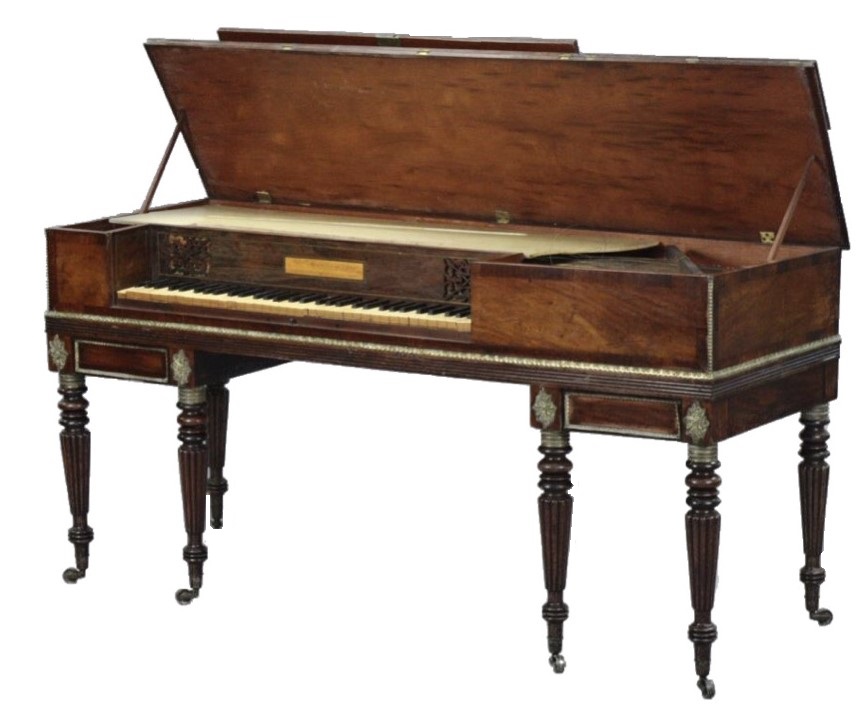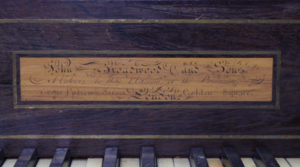John Broadwood and Sons 1815 – Compensator
Description

| Date: | 1815 |
| Origin: | London |
| Serialnumber: | 19968 |
Within a few years, the square piano underwent a rapid development. Improvements were constantly being made to refine the sound, a longer lasting tuning and the way of playing. This elegant square piano was made in 1815 and shows a special and very early improvement. The entire case construction was always made of wood. Hence, attempts were made to strengthen the entire instrument by installing a metal bar and thus to prevent twisting of the case (which was often quite normal due to the high tension of the strings) and improved tuning.
The case of the instrument is made of mahogany and rosewood with revolving band inlays in brass. The instrument stands on 6 original turned legs with fire-gilt bronze rings. The entire instrument is made in the typical “Regency-Style“. At the front there are two drawers. The keyboard is made of ivory and ebony. The instrument has a wooden pedal for the dampers. The action is a double action with leathered hammers, single dampers and is double strung. The instrument has the original dust cover, which is located above the strings and inscribed with the number 157 on the back. The same number is also found on the wrest plank. The nameboard is made from different woods and signed in a cartouche:
“John Broadwood and Sons.
Makers to His Majesty and the Princesses
Great Pulteney Street London Golden Square.”

Nameboard John Broadwood & Sons 1815 Compensator Square Piano – Eric Feller Collection
The serial number is located on the inside of the instrument and reads 19968. Based on this serial number, the instrument was made in 1815.
The company John Broadwood produced various models of square pianos. Depending on the design and the used woods the prices varied. This piano has to be one of the expensive models. The standard models were mostly held in mahogany and simpler decorated with some ribbon inlays. The use of rosewood and brass inlays is a clear sign of a high-priced instrument.
Interesting at this instrument is the embedded metal bar above the soundboard. Occasionally, there have been repeated attempts to improve the entire case construction and tuning through reinforcements. The constantly growing range of the compass and the associated increasing tension resulted in many twisted instruments and damaged cases. Looking at grand pianos, these reinforcements prevailed from 1820 onwards. Exceptional examples of these reinforcements are the “Compensator Frame” fortepianos made by Stodart (for more information on these instruments – click here).
Another important factor and a prerequisite for these innovations were the improvements of manufacturing and production processes, which led to higher material quality.
John Broadwood was born on 6th October 1732 in Oldhamstocks near Cockburnspath in Scotland. He learned the profession of being a cabinetmaker like his father before.
In 1761 he started working for Burkat Shudi (1702 – 1773) in London and in 1770 became his business partner. In 1771 he opened his own shop on Great Pulteney Street in London. In 1769 he married Burkat Shudi’s daughter Barbara in her first marriage and had four children with her. After his wife’s death in 1776 he married Mary Kitson in 1781 and had six children with her. He died on 17th July 1812 in London.
Other surviving square pianos by John Broadwood and Sons:
- 1814 square piano (No. 8666) – Stanford University Department of Music, Stanford USA
- 1816 square piano (No. 20108) – Banchory Crathes Castle, The National Trust for Scotland, UK
- 1816 square piano (No. 20953) – Tredegar House, Newport UK
| Length: | 63 cm |
| Width: | 165 cm |
| Height: | 25 cm |
| Circumference: | 5 ½ octaves (FF – c4) |
| Mechanics: | Double Action with single dampers |
| Pedals: | 1 Pedal - dampers |
| Signature: |
„John Broadwood and Sons. Makers to his Majesty and the Princesses Great Pulteney Street London Golden Square.“ |

